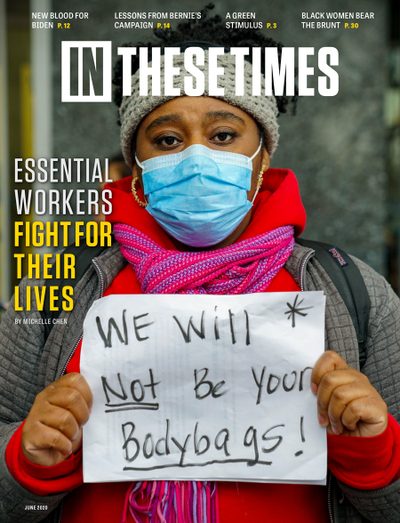SARS Lessons Lost
What the United States should have learned from SARS—and blatantly ignored.
Indigo Olivier

Contrary to President Trump’s claims, the new coronavirus pandemic was not “unforeseen” and did not come “out of nowhere.” The outbreak marks the third time in the past 30 years that a coronavirus has become a global health threat, each time with new warnings from public health officials for the international community to better prepare for the next one.
On March 12, 2003, the World Health Organization (WHO) issued a global alert about an unusual pneumonia and flu-like illness which came to be known as SARS, severe acute respiratory syndrome. Like Covid-19 today, the cause of SARS was identified as a strain of coronavirus previously unknown in humans. By the time the WHO had declared SARS “contained” in July 2003, it had infected more than 8,000 people and killed more than 800.
In his August 2003 article for In These Times, “Learning from SARS,” epidemiologist Mark Parascandola wrote:
Why should SARS warrant such global attention? … because there is a limited window of opportunity within which to defeat the disease. David Heymann, WHO executive director for communicable diseases, explained, “When we put out the announcement about this new disease, one of our major concerns was that maybe we could stop this disease from becoming endemic.”
Moreover, while the number of deaths has been relatively small so far, that could change dramatically if the disease were to spread freely throughout Asia. Estimates of the death rate for people infected with the SARS virus run from 4% to 10%. The death rate from the Spanish Flu, which circled the globe and killed 50 million people between 1918 and 1920, was lower, about 3%. But what made the Spanish Flu so deadly was not a high mortality rate, but the fact that it was so easily transmitted and infected entire populations.
International cooperation and swift efforts to track and isolate infected individuals effectively contained the 2003 SARS outbreak within months. As Parascandola wrote in 2003, “the real lesson here is not about SARS, but about our capacity to respond to the next big biological threat.”
Unfortunately, after the WHO declared a global health emergency in January of this year and an official pandemic March 11, Trump was still conflating Covid-19 with the flu as late as March 27. By then, the United States had more than 100,000 cases. And despite the devastating effects in China and Italy, shelter-in-place orders only began March 19, while a number of states already are beginning to reopen. Trump also dismantled the team responsible for dealing with pandemics in 2018, proposed deep cuts to the Centers for Disease Control and Prevention and halted U.S. funding for the WHO.
The administration has not only failed to learn from the 2003 SARS outbreak, but is actively failing to learn lessons from Covid-19.
Indigo Olivier is a reporter-researcher for The New Republic and a 2020-2021 Leonard C. Goodman investigative reporting fellow. Her writing on politics, labor and higher education has appeared in the Guardian, The Nation and Jacobin, among other outlets.









